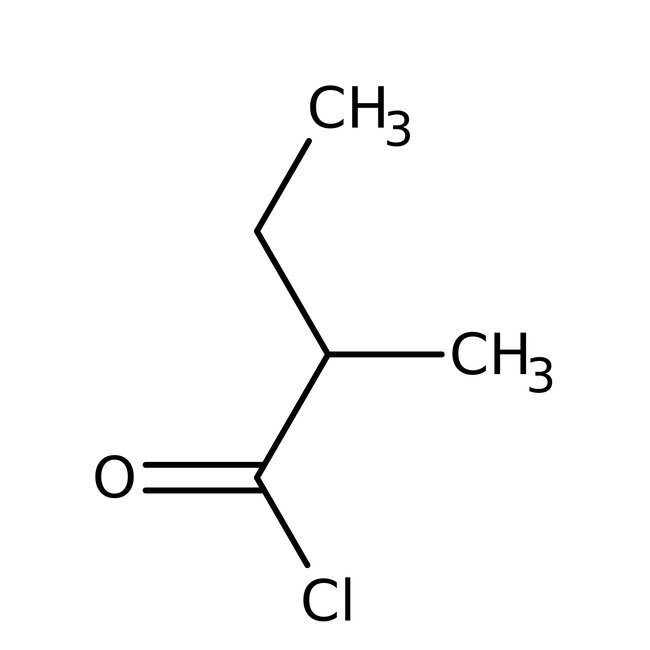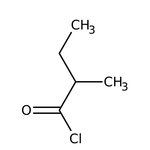Search Thermo Fisher Scientific
Thermo Scientific Chemicals
2-Methylbutyryl chloride, 99%
CAS: 57526-28-0 | C5H9ClO | 120.576 g/mol
| Catalog Number | Quantity |
|---|---|
| FSKB22599.14 | 25 g |
Catalog number FSKB22599.14
View Price:Sign InSign in to see your account pricing. Need an account? Register with us today.
Quantity:
25 g
Specifications
Chemical Name or Material2-Methylbutyryl chloride
CAS57526-28-0
Health Hazard 1H225-H314-H335
Health Hazard 2GHS H Statement
H225-H314-H318
Highly flammable liquid and vapour.
Causes severe skin burns and eye damage.
Causes serious eye damage.
H225-H314-H318
Highly flammable liquid and vapour.
Causes severe skin burns and eye damage.
Causes serious eye damage.
Health Hazard 3P210-P233-P235-P240-P241-P242-P243-P260-P264b-P271-P280-P301+P330+P331-P303+P361+P353-P304+P340-P305+P351+P338-P310-P363-P370+P378q-P501c
View more
2-Methylbutyryl chloride was used in the synthesis of 2-methylbutyramide, N-((R,S)-2-methylbutanoyl)salicylhydrazide, 2-methyl-1-phenyl-1-butanone, 1,1’-(1,3,7,9-tetrahydroxydibenzofuran-2,6-diyl)bis(2-methylbutan-1-one).
This Thermo Scientific Chemicals brand product was originally part of the Alfa Aesar product portfolio. Some documentation and label information may refer to the legacy brand. The original Alfa Aesar product / item code or SKU reference has not changed as a part of the brand transition to Thermo Scientific Chemicals.
Applications
2-Methylbutyryl chloride was used in the synthesis of 2-methylbutyramide, N-((R,S)-2-methylbutanoyl)salicylhydrazide, 2-methyl-1-phenyl-1-butanone, 1,1’-(1,3,7,9-tetrahydroxydibenzofuran-2,6-diyl)bis(2-methylbutan-1-one).
Solubility
Reacts with water.
Notes
Store away from oxidizing agents, amines, bases, alcohols, active metals, water/ moisture.
2-Methylbutyryl chloride was used in the synthesis of 2-methylbutyramide, N-((R,S)-2-methylbutanoyl)salicylhydrazide, 2-methyl-1-phenyl-1-butanone, 1,1’-(1,3,7,9-tetrahydroxydibenzofuran-2,6-diyl)bis(2-methylbutan-1-one).
Solubility
Reacts with water.
Notes
Store away from oxidizing agents, amines, bases, alcohols, active metals, water/ moisture.
RUO – Research Use Only
General References:
- Sabrina Heng; Katharine M. Harris; Evan R. Kantrowitz; Sabrina Heng; Katharine M. Harris; Evan R. Kantrowitz. Designing inhibitors against fructose 1,6-bisphosphatase: Exploring natural products for novel inhibitor scaffolds. European Journal of Medicinal Chemistry. 2010, 45 (4), 1478-1484.
- Elmore JS, et al. Effects of sulphur nutrition during potato cultivation on the formation of acrylamide and aroma compounds during cooking. Food Chem. 2010, 122 (3), 753-760.



